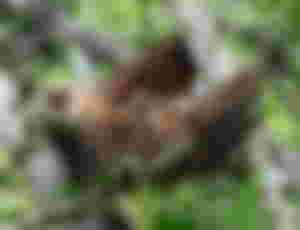
I'm an animal lover. Specifically of the variety who prefer the companionship of animals to humans. You know, the best kind of people! We live in our houses with our animal family members and eschew the rest of the world until it becomes impossible to do so.
This isn't going to be a post about pets, though. I was tempted to write about dog breeds, language learning, or some other subject I know so well that I don't have to research, as I'm currently deep in writing a short story and doing a research-intensive article about the Giza pyramids. Unfortunately, I'm an addict who can't help myself, so I decided to pick sloths.
I know enough about these amazing creatures that I didn't have to do extensive research, but this is also a subject I think people enjoy. After all, who isn't fascinated by the slowest mammals on earth?
Oh, and for those of you into more exotic pets, there are states where these little guys are legal. They take an extraordinary amount of work, though!
What are sloths?
Before we move on to what makes these little fellows so fascinating, let's define what a sloth is for anyone stumbling on here who doesn't know.
A sloth is a tropical mammal that lives in Central and South America. They spend their days mostly hanging upside down from trees, and they move very, very slowly. They also tend to grow moss on their bodies, mostly their backs. There's a reason for that, as you'll soon see!
There are 6 species of sloth, coming in two different varieties: two-toed and three-toed. While both types have three claws on their hind limbs, two-toed sloths only have two claws on their fingers. I suppose they're due for a slight name change!

Oh, and these claws aren't anything to sneeze at, either. Just look at those pictures! They can actually grow between 2-4 inches. Because of this, they spend almost all of their time in trees, hanging out mostly in rain forests, mangroves, and cloud forests – mostly warm, tropical places. The fossil record indicates, however, that they once were able to inhabit some places in North America as well.
Three-toed sloths actually spend their entire lives in the very tree that they were born in!
They're slow! But only out of the water...

I made a slight mistake earlier when I said they were the slowing mammals on earth. In fact, they are the slowest-moving animals, period! They crawl at a speed of about 1ft per minute only. Just look at any video of them and you'll see that these guys make even snails look fast.
That said, they are faster in the water. They are naturally buoyant and can perform a breaststroke just like a human, which is actually helpful for them. While they spend most of their time in trees, rain forests, in particular, are prone to flooding. Being able to swim, especially if you're a creature who can't really race to the top of a tree, is essential. Also, especially in the case of three-toed sloths, swimming also allows them to be able to get to new places much faster than crawling.
This slowness is a defense mechanism.
This sounds like a terrible disadvantage, doesn't it? How are you going to survive when you can't outrun anything that wants to eat you? Being so slow actually helps them camouflage, hiding out in the trees so that many predators that rely on sight and the ability to perceive movement aren't able to detect them.
Mating sloths are a recipe for war...kinda.
Sloths are slow, tree-dwelling, solitary animals. That basically means that when it comes to mating, they need to be able to find each other first.
Females will come down from their trees and defecate at its base. You know, they have to leave their scent somewhere. She will also start on her mating call to let any eligible bachelors know she's in season. With that, the race is on!
Said eligible bachelors will start the slow, onerous race to get to their lady. This is possibly the only time sloths will fight each other, as occasionally two will get to her tree at the same time. And if you've never seen sloths fight, it's pretty cute. There's nothing like watching two animals fighting for dominance and absolutely failing to look ferocious at all.
Once pregnancy occurs, gestation varies depending on the type of sloth. The pale-throated sloth has a gestation period of about 5-6 months, but the Hoffman's two-toed sloth can take almost 11 ½ months! But regardless of species, all sloths only birth a single baby at a time.
Their primary diet is leaves - and a lot of them!
This one should be somewhat obvious, as these are tree-dwellers, but only the three-toed sloth is an herbivore! The two-toed sloths will eat insects, small lizards, and fruit in addition to foliage.
All species of sloths have multi-chambered stomachs because the leaves they eat are difficult to digest. Much like pandas and their fixation on bamboo (that's probably a future article), the leaves eaten by sloths don't have much nutritional value, contributing to their sluggishness.
It's a chore for sloths to poop.
Remember when I said that the female sloth will leave her scent on her tree via pooping at its base? Yeah, that's just how sloths normally defecate, even outside of mating season. They trek down from their tree once a week solely to relieve themselves at its base!
Why do they only do this once-per-week? It takes an entire month for a sloth to digest a single meal, that's why! When they go, they eliminate about 1/3 of their body weight.
Sloths are the only animals that can hang upside down indefinitely.
Sloths have a special adaptation that no other animals have, and because of it, they can hang upside down for as long as they like. They can eat, mate, and even give birth upside down!
Their internal organs never press against their diaphragm and affect their breathing due to being anchored on their abdomens.
They may hold a cure to cancer.
This one is a little iffy, as there are many animals that scientists claim could help us cure cancer, but in this case, it isn't the animal itself, it's the fungus that grows on its back!
Due to living in trees, their fur becomes covered in algae. For a slow sloth, this means essential camouflage against predators, such as eagles. For humans, it could spell a cure for certain strains of breast cancer.
A variety of fungi can be found growing on sloths, and it appears that all of them are useful when it comes to fighting cancer. Granted, mushroom enthusiasts will tell you that you don't have to go so far as harvesting fungi off of sloths, as many species of fungi have cancer-fighting properties.
They're super gross (in the wild), but that's also a defense mechanism.
In captivity, these little cuties are kept clean and happy, with no predators around to catch and eat them. In the wild, however, they have another defense in case their sluggishness fails them: smelling awful.
These guys collect not only fungus but all sorts of icky things in their fur. While your dog may have no trouble eating the most foul-smelling things he comes across, most predators turn their noses up at the sloth. They just don't seem edible!
That's all for now. Let me know what you think.

...and you will also help the author collect more tips.



Cool! Sloths are one of my favorite animals. They receive so little attention when compared with other animals. But in fact, sloths are unique Thanks for the interesting article!